This post contains affiliate links.
When COVID-19 shut down the theatre industry in London, it left Zoe and her partner in the lurch for work. But, they made lemons out of lemonade, and chased a long-time dream of living on the canalways of England in a narrowboat!
It’s significantly reduced their monthly living expenses, and given them their own space which they didn’t have in their previous pricey West London house share. They’ve only been on the water for a month, but are already loving being closer to nature.
I really love their narrowboat because it’s in “original” condition right now before they do some cosmetic updates, so you can see what old-fashioned narrowboats looked like! We got to do a Q&A with Zoe (@zogreenfield) which you can read after the photo tour below.
Don’t miss other interesting tiny homes – join our FREE Tiny House Newsletter for more!
Couple and Rescue Pup Continuously Cruising in Narrowboat
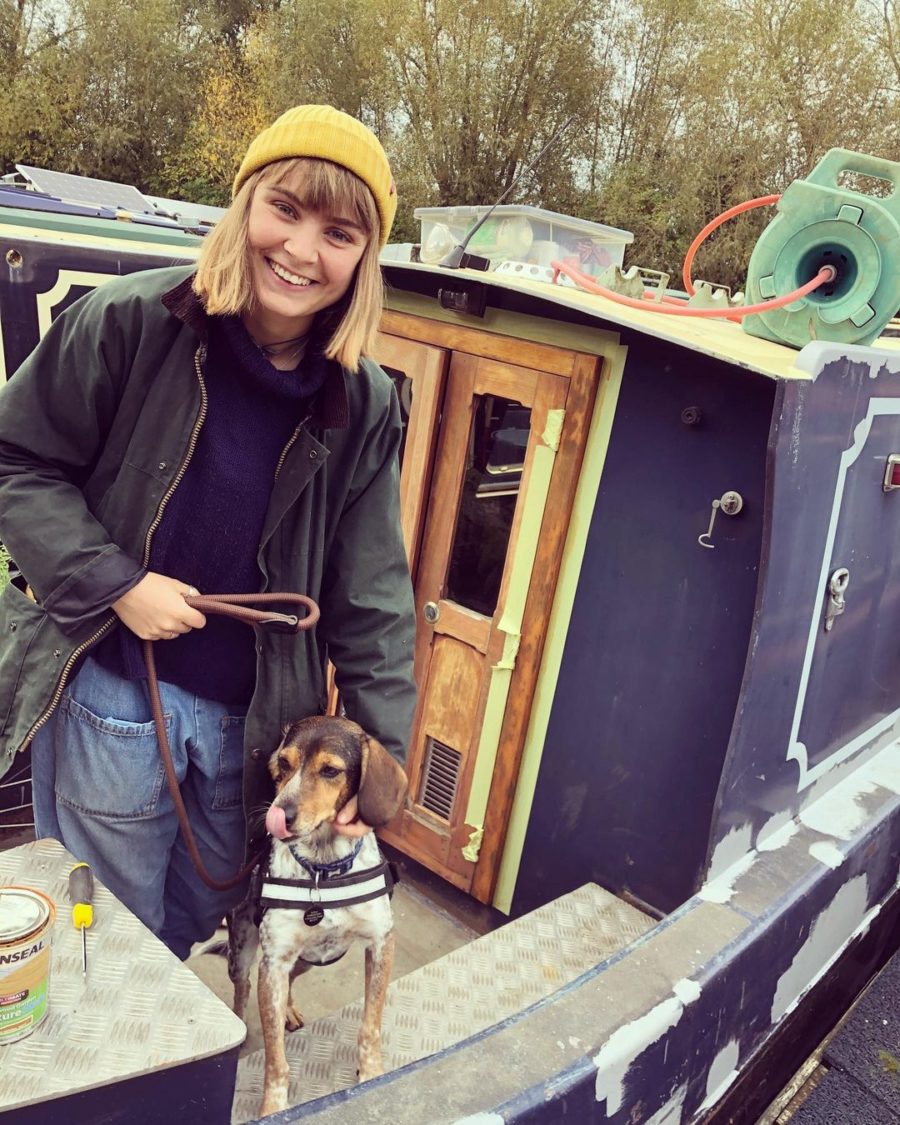
Images via @zogreenfield/Instagram
There are all kinds of lovely places to moore.
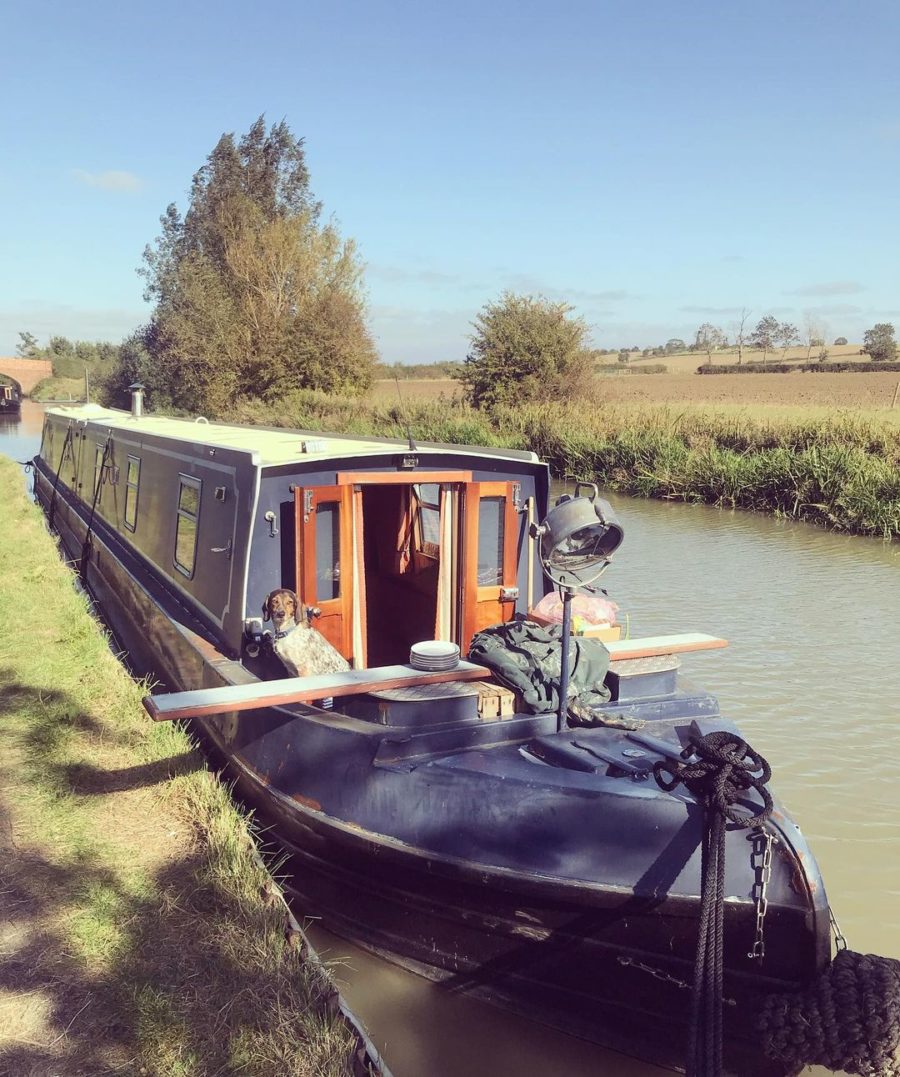
Images via @zogreenfield/Instagram
Zoe made space for all her plants.
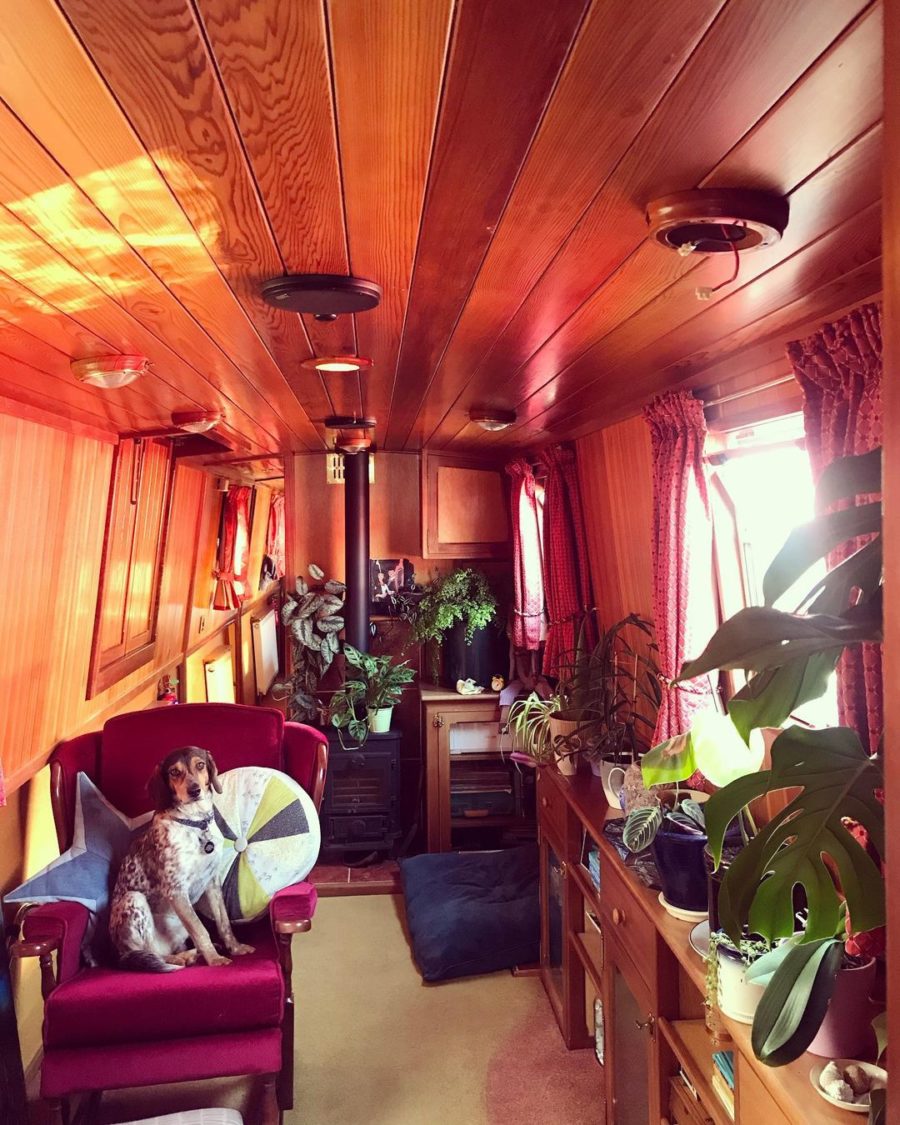
Images via @zogreenfield/Instagram
Here’s their lounging area.
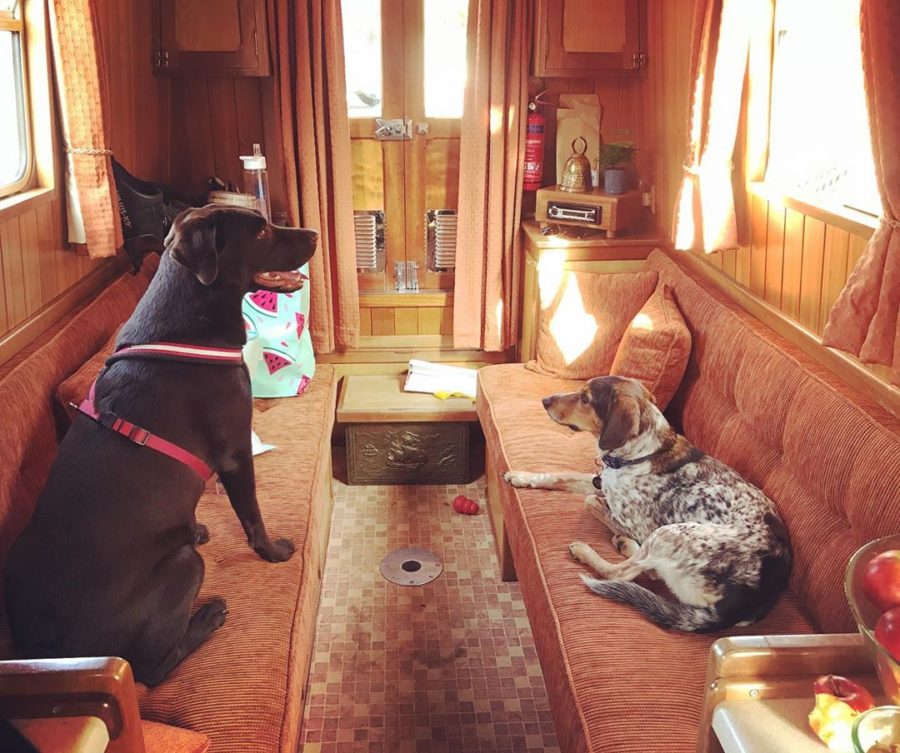
Images via @zogreenfield/Instagram
Those doors open up to the crisp air outside.
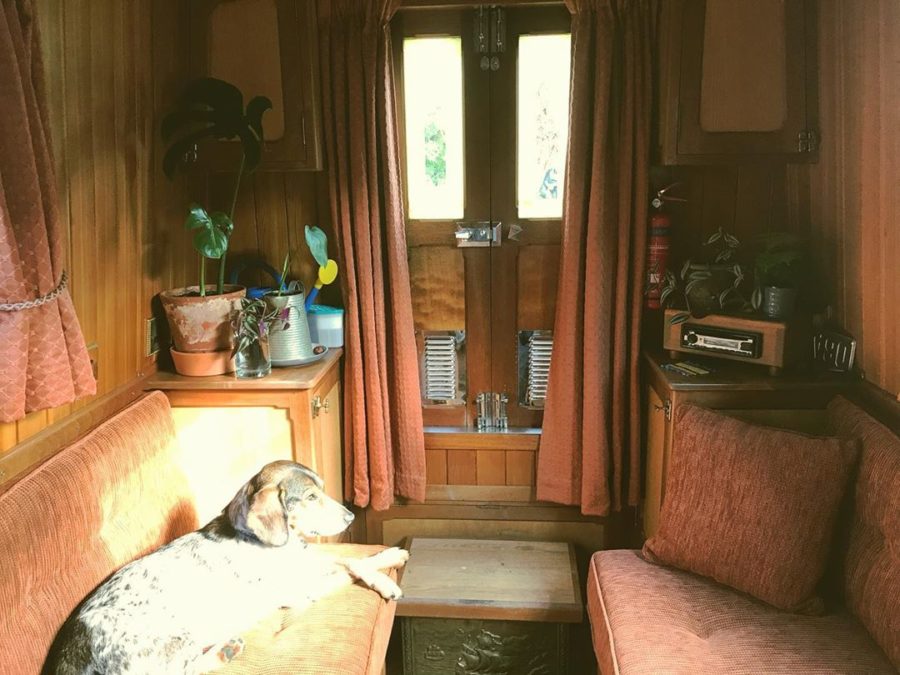
Images via @zogreenfield/Instagram
Time to hang up some pictures!
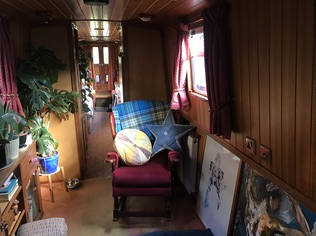
Images via @zogreenfield/Instagram
Here’s their tiny kitchen.
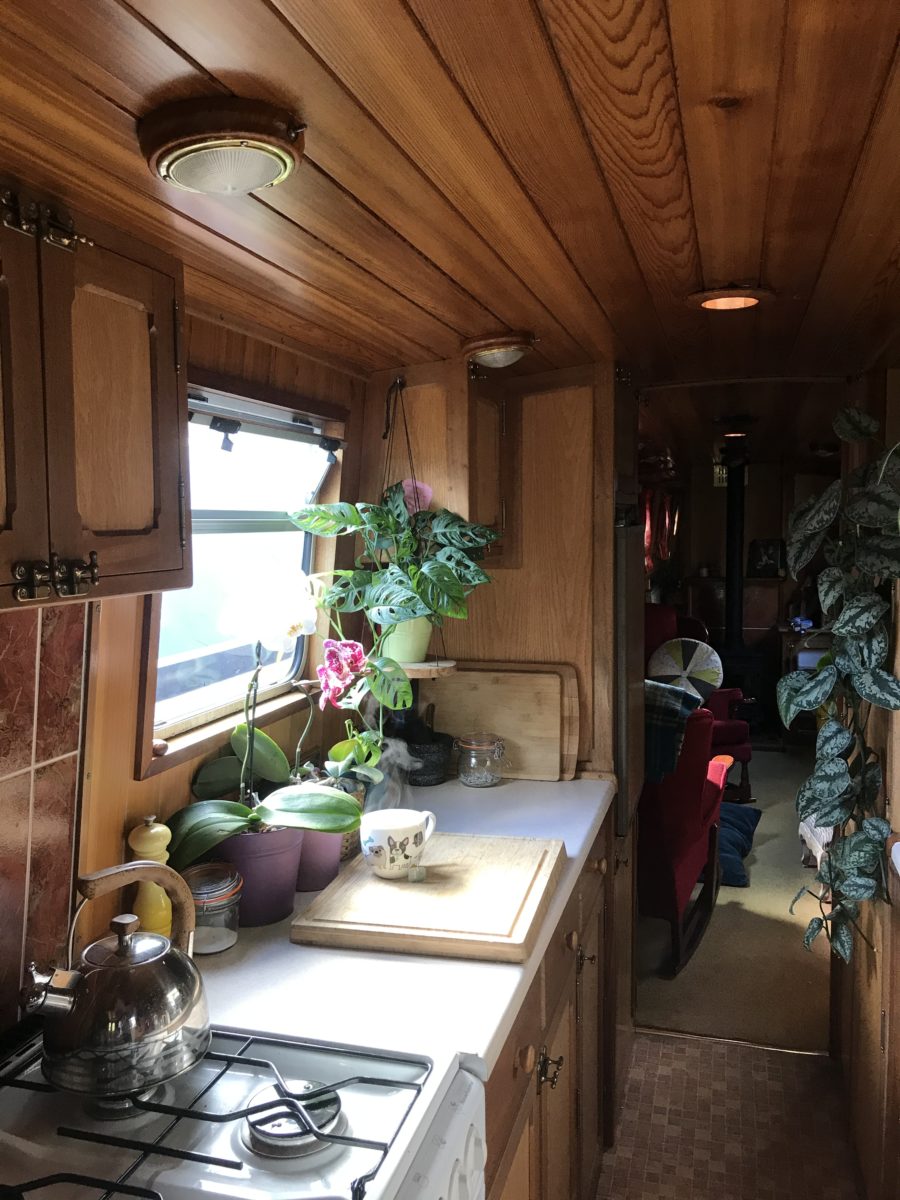
Images via @zogreenfield/Instagram
And their bedroom!
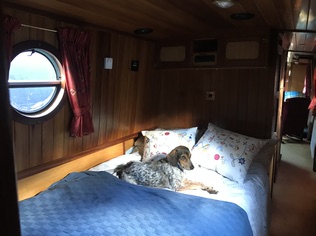
Images via @zogreenfield/Instagram
Interview with Zoe on Narrowboat Living
What are your name(s)?
My name is Zoe Greenfield, and I live with my partner Adam and our rescue dog Arthur.
Where do you live? How long have you lived tiny?
At the moment we are CCing in and around Oxford for the winter, and we will probably head back towards London next spring (in canal terms CCing that translates as ‘continuously cruising’) We’ve only been aboard for 1 month, before that we lived in a rather pricey house share in west London. So we’re completely new to boat life, and slowly learning the ropes!
What do you do for work? Or do you travel full-time?
We are both Actors, but because of the recent pandemic our industry is struggling. So my partner is going to spend a year getting in some extra acting training and I am delving into the floristry world. Gardening is a passion of mine and we hope to have a floating garden on our Narrow Boat roof come the spring.
Why did you decide to go tiny? What are you hoping to get out of living tiny?
We loved the idea of the freedom living aboard a narrow boat can give you. For me, living tiny means you have to really think about the things you own. You have to think ‘do I really need this in my life’. And it can be quite therapeutic living a minimal lifestyle. But we also have some really clever storage solutions onboard, so not everything had to go. The books and plants managed to remain.
How did you first learn about narrowboat life?
A place we always used to walk our dog in London was along our local stretch of canal. From there we always got chatting to boaters, its such a friendly community of people. We would spend our evening admiring the boats we saw, and saying this like ‘If we had a boat I would do the coach lines that colour’ or ‘oh wow look at that veg patch on their roof!’ and eventually our dream became our reality.
How did you acquire your narrowboat? Are you comfortable sharing how much it cost? Have you done any renovations?
We seriously shopped around for a while, and tried to see as many boats as we could to get a feel of what we were looking for. The Windy Lass came just shy of £40,000 and we have started renovating the outside before the winter has started to set in. Over time we intend to do a full re-paint of the outside, and make some tweaks of the layout and colour scheme on the inside. But for now she’s perfectly liveable and proofing to be super cosy.
What are bills/utilities like compared to before?
Oh so much cheaper! We have two bottles of gas onboard for the gas cooker and hob, to get one refilled costs around £35 and that lasts us around 2-3 months. We get electricity and hot water through solar power and running the engine which uses diesel. A full tank costs us around £200, we run the engine for about an hour in the morning to charge the batteries and it’s dependent on how much we move to how often we top that up. Water comes from water points along the canal. We pay a canal and river license to the Canal and River Trust and we have a special key which allows us access to the taps. Other than that we use smokeless coal, logs and kindling to fuel our multifuel stove. In the winter that’s around £40 a month and in the summer that goes down to £0. That being said, we always put something aside for up-keep and repairs. Something always need maintaining or fixing when you have a Narrow Boat,
How did you find a place to “park” your boat? Or do you travel?
We moor along the canal wherever there is a free space and as long as we’re not on a spot that requires a permanent mooring. As long as we move every two weeks and cover 20 miles a year, we’re within the continuously cruising guide lines.
Before going tiny, what was life like?
Renting was expensive, and we could only ever afford a house share, so it felt cramped. Now we have less space, but the space is ours and its never cramped, just cosy.
Is there anything from your old life that you miss?
Not having to pump out the toilet would be the main thing I think. Or when you discover your water tank is empty at 11pm and you’re half way through your nice hot shower (that only happened once, lesson learnt)
What benefits are you experiencing after going tiny?
The freedom. Being closer to nature. Having a place we can call ours, that we can make a home for ourselves.
What about some challenges?
The maintenance. There is always something that needs your attention. Sometimes you just have to pray its not a big job that needs a professional to come out to you because that’s when things can get costly.
What makes your tiny home special?
She’s our first boat, so I think she’ll always have a special place in our hearts. I believe Narrow Boats can be such personal things, you can put a lot of your personality into them.
What is your favorite part of your tiny home?
We have a lovely big side hatch on the starboard side of the boat. When that’s open and the sun is shining in it’s glorious even on the crisp chilly mornings! Some people also call it a duck feeder. The ducks know when they’re open and they come over hoping to get some dinner.
What helpful advice would you give to others interested in going tiny?
I would say you can’t afford to be materialistic about certain things. So have a good long think about the things you really can’t live without. That being said there are some amazing tiny space storage solutions out there. Pinterest will be your best friend when discovering how and where to store things. And if going tiny for you means living on a narrow boat, always get an external surveyor to check out your hull for you.
Anything I didn’t ask about that we should know?
You have to be very ethical when it comes to some things on a Narrowboat. The water from your sinks and shower/bath goes straight into the canal. So it’s important you use plant based and non toxic cleaning products. Some say you don’t live on a Narrow Boat, you live on the canal. The NB just keeps you warm and dry. So it’s important to look after and maintain the eco system you have around you.
Learn More:
Related Stories:
- One Couple’s 7 Years Living on a Narrowboat in Derbyshire, England!
- Couple Escapes London Rent With Narrowboat Cottage
- Small Space Living in a Narrowboat Tiny Home in London
Our big thanks to Suzi for sharing! 🙏
You can share this using the e-mail and social media re-share buttons below. Thanks!
If you enjoyed this you’ll LOVE our Free Daily Tiny House Newsletter with even more!
You can also join our Small House Newsletter!
Also, try our Tiny Houses For Sale Newsletter! Thank you!
More Like This: Tiny Houses | House Boats | Floating Homes | Q&As
See The Latest: Go Back Home to See Our Latest
This post contains affiliate links.
Natalie C. McKee
Latest posts by Natalie C. McKee (see all)
- Urban Payette Tiny House with Fold Down Deck! - April 25, 2024
- Luxury Home Realtor’s Tiny House Life in Florida - April 25, 2024
- Handcrafted, Eco-Bohemian Tiny House with a Deck - April 25, 2024




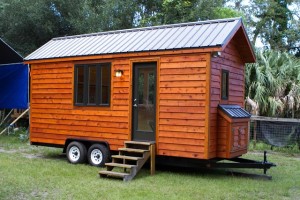

There are numerous books about living on a NarrowBoat. Acquire some of these books. Learn everything you can about NarrowBoats and your life living on a NarrowBoat will just get easier as the years pass. I think you both have made a very wise & intelligent decision to live on this NarrowBoat.
There are books for everything! Love this.
Nice and a good interior more like the original. But the original had a freight hold forward that was turned into cabin.
And a much better cheaper way of life that the last article of the one chained to an expensive marina.
For power I suggest a boat wind generator could cut much of the diesel running at a fraction of the cost.
If you are still going to use the diesel get a 200amp high output alternator that can be controlled and fast charge the batteries. They love it to 80% charge. And you must charge them to 110% at least 1/month if lead batteries as likely.
For sewage pumping, an electric pump.
Propane on a boat you need to be very careful as sinks to the bottom and builds up can blow up badly. Have a detector and E shut off valve and learn about it before using. I use 12vdc electric insulated cooking pots, pans and even a lunchbox thingy. For heating a wood stove, E blankets.
Thanks for sharing. Great place. Looks like you have two dogs (or does yours have a friend over?) and I’d love to see a floorplan. Thanks. Bonny